
Oecophoridae is a family of small moths in the superfamily Gelechioidea. The phylogeny and systematics of gelechoid moths are still not fully resolved, and the circumscription of the Oecophoridae is strongly affected by this.

The Elachistidae are a family of small moths in the superfamily Gelechioidea. Some authors lump about 3,300 species in eight subfamilies here, but this arrangement almost certainly results in a massively paraphyletic and completely unnatural assemblage, united merely by symplesiomorphies retained from the first gelechioid moths.

Gelechioidea is the superfamily of moths that contains the case-bearers, twirler moths, and relatives, also simply called curved-horn moths or gelechioid moths. It is a large and poorly understood '"micromoth" superfamily, constituting one of the basal lineages of the Ditrysia.

The Coleophoridae are a family of small moths, belonging to the huge superfamily Gelechioidea. Collectively known as case-bearers, casebearing moths or case moths, this family is represented on all continents, but the majority are found in temperate areas of the Northern Hemisphere. They are most common in the Palearctic, and rare in sub-Saharan Africa, South America, and Australia; consequently, they probably originated in northern Eurasia. They are relatively common in houses, they seek out moist areas to rest and procreate.

The Ethmiinae are a subfamily of small moths in the superfamily Gelechioidea sometimes included in the Elachistidae or the Oecophoridae, but mostly in the Depressariidae as a subfamily Ethmiinae.

The Blastobasidae are a family of moths in the superfamily Gelechioidea. Its species can be found almost anywhere in the world, though in some places they are not native but introduced by humans. In some arrangements, these moths are included in the case-bearer family (Coleophoridae) as subfamily Blastobasinae. The Symmocidae are sometimes included in the Blastobasidae as subfamily or tribe.

Scythrididae is a family of small moths in the superfamily Gelechioidea. The family is sometimes included in the Xyloryctidae as a subfamily Scythridinae, but the Xyloryctidae themselves have sometimes been included in the Oecophoridae as subfamily. Scythrididae adults are smallish to mid-sized moths, which when at rest appear teardrop-shaped.

Pterolonchidae is a small family of very small moths in the superfamily Gelechioidea. There are species native to every continent except Australia and Antarctica.

Pseudatemelia flavifrontella is a species of gelechioid moths.
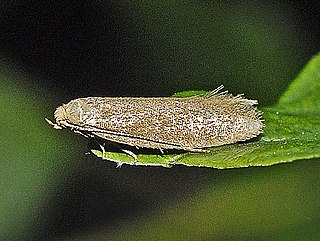
Pseudatemelia subochreella, the straw-coloured tubic, is a species of gelechioid moth.
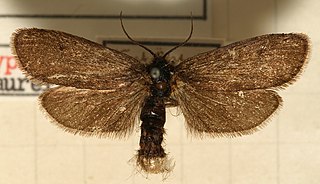
Lypusa is a genus of moths of the Lypusidae family, traditionally held to be a monotypic lineage of Tineoidea. However, it may actually belong to the same lineage of Gelechioidea as the Amphisbatinae.

The Depressariinae – sometimes spelled "Depressiinae" in error – are a subfamily of moths in the superfamily Gelechioidea. Like their relatives therein, their exact relationships are not yet very well resolved. It has been considered part of family Elachistidae sensu lato or included in an expanded Oecophoridae. In modern classifications they are treated as the distinct gelechioid family Depressariidae.

The Oecophorinae are the nominate subfamily of moths in the concealer moth family (Oecophoridae). They are part of the insufficiently studied superfamily Gelechioidea, and like their relatives, the circumscription of this taxon is disputed.

Pseudatemelia is a genus of gelechioid moths.
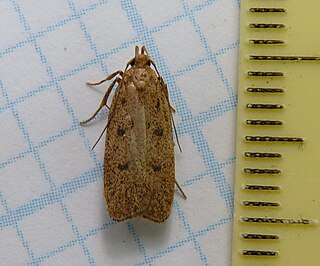
The Symmocinae are a subfamily of moths in the superfamily Gelechioidea. These small moths are found mainly in the Palearctic and Africa.
Paratemelia is a genus of gelechioid moths. In the systematic layout used here, it is placed in the subfamily Amphisbatinae of the concealer moth family (Oecophoridae). Delimitation of Amphisbatinae versus the close relatives Depressariinae and Oecophorinae is a major problem of Gelechioidea taxonomy and systematics, and some authors separate the former two as full-blown families, and/or include the Amphisbatinae in Depressariinae, or merge them in the Oecophorinae outright.

Telechrysis is a genus of gelechioid moths and only genus in the Telechrysidini tribe. The genus itself contains only one species, Telechrysis tripuncta, which is found in most of Europe, except the Iberian Peninsula, the Benelux, Ireland, Lithuania, Croatia, Austria and Greece.
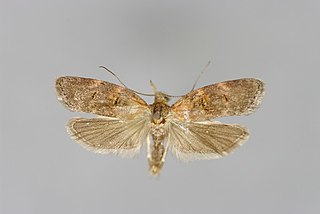
Anchinia is a genus of gelechioid moths.
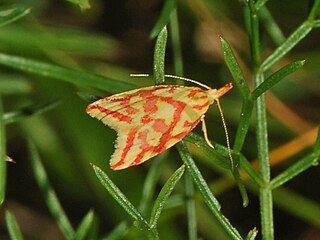
Hypercallia is a genus of gelechioid moths.
Fuchsia is a genus of gelechioid moths and only genus of the Fuchsiini tribe. In some systematic layouts, it is placed in the subfamily Amphisbatinae of the concealer moth family (Oecophoridae). Delimitation of Amphisbatinae versus the closely related Depressariidae and Oecophorinae is a major problem of Gelechioidea taxonomy and systematics, and most authors separate the former two as full-blown families, and/or include the Amphisbatinae in Depressariidae, or merge them in the Oecophorinae outright.


















